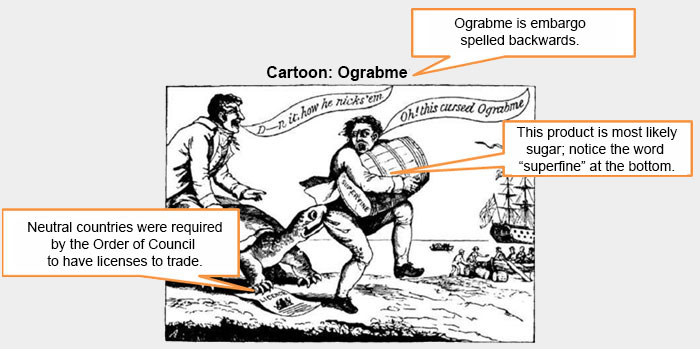
At the beginning of the 19th century, the United States was a young nation still recovering from the American Revolution. By 1803, Great Britain and France were embroiled in a conflict in Europe. To gain the upper hand, both countries of this European conflict tried to keep the other from getting important supplies. To accomplish this, both Great Britain and France tried to block each other from trading with the United States. Great Britain began by setting a series of British naval blockades where British ships lined up outside of important American ports in an effort to keep the French from trading with Americans for supplies.
→Think about this –How do you think this would impact the economy of the United States at this time? How would the actions of Great Britain and France impact the policy of neutrality that Washington advised for the country in his farewell address?
Great Britain went a few steps further in its policies. In 1807, the British passed the Orders of Council, an act that restricted neutral countries from trading with France or any French colonies without an appropriate license. The Orders of Council also allowed the Royal Navy to set up naval blockades at any French port or the ports of their allies. The Royal Navy also instituted the policy of impressment where the British would remove American men from U.S. ships and force them to serve in the Royal Navy.
In response to the British and French trade restrictions, enacted the Embargo Act of 1807. The act, which closed ports in the United States to foreign trade, proved unpopular with Americans and hurt the U.S. economy. The cartoon below is called Ograbme; it was written in 1807 in response to the Embargo Act of 1807. Analyze the cartoon to learn more.

Source: Ograbme, Urban, Wikipedia.
Analyze a cartoon – After analyzing the cartoon above, answer the questions that follow.


In 1809, the Embargo Act of 1807 was repealed, or made no longer valid, by Congress. It was replaced with the Non-Intercourse Act in May 1810, which specifically prohibited trade with Great Britain and France. This act also was unsuccessful, which led to Congress passing a bill that promised if either Great Britain or France would end trade restrictions against the United States, the United States would impose the Non-Intercourse Act against the opposing country.
When Napoleon implied that he might drop France’s trade restrictions against the United States, blocked all trade with Great Britain. During that same year, some of the newly-elected members of Congress, including and , began campaigning for a war against Great Britain in response to British involvement of agitating American Indians’ hostility against American settlers in the West. They also believed that the British had violated many of the rights associated with the neutrality of the United States with the policy of impressment.
Eventually, all of the issues, and tensions surrounding them, led to the beginning of the War of 1812. Read the causes of the war below, and click on the flag of the country being described.
![]()